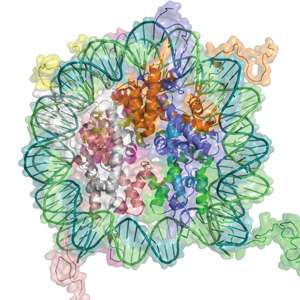Genomic survey reveals that abnormal initiation sites for gene expression may promote stomach cancer

A*STAR researchers show that changes in histone modifications accelerate a type of stomach tumor known as gastric adenocarcinoma—a cancer that occurs more frequently in Asian populations than Western populations.
While cancer cells typically contain numerous genomic mutations that alter genetic activity responsible for proliferation and migration, other 'epigenetic' mechanisms are also at play. For example, histone proteins that support chromosomal DNA (see image) can undergo chemical modifications that may either boost or restrain gene expression.
The research team led by Patrick Tan of the A*STAR Genome Institute of Singapore used a technique known as nanoscale chromatin immunoprecipitation sequencing (nano-ChIP-seq) as a starting point to investigate gastric adenocarcinoma. This technique, which was developed at A*STAR, allows researchers to specifically analyze chromatin modifications occurring at different genomic sites, making it possible to predict the genes that are most likely to be active or inactive in a given cell.
By comparing nano-ChIP-seq analyses of gastric adenocarcinoma and normal stomach tissue, Tan and colleagues identified hundreds of genomic sites with distinct differences in histone modification. Although many of these differences were observed at known promoters—sequences that regulate the activity of nearby genes—many more were found at 'cryptic promoters', which had not yet been described.
These unconventional promoters seem to profoundly alter gene expression. In several instances, the researchers determined that cryptic promoters contribute to the production of abnormal protein variants. Analysis of patient tumor samples suggested that these changes may directly influence the patient's health.
"Patients whose stomach cancers expressed such altered genes experienced very poor clinical outcomes, which indicates that cryptic promoters may functionally contribute to aggressive disease," says Tan.
The sequence elements contained within promoters act as a 'landing platform' for various transcription factor proteins that directly govern gene expression. Tan and colleagues found that many of the cryptic, cancer-associated promoters were bound by transcription factors that form part of the polycomb repressor complex 2 (PRC2), a transcription factor assembly that contributes to histone modification. Importantly, PRC2 is also highly active in embryonic stem cells, which remain biochemically locked into an 'immature' developmental program.
"This suggests that stomach cancers may 'regress' toward a more primitive state, exhibiting properties similar to cells during very early stages of development," says Tan.
Although this study only gives initial data for one particular cancer, Tan believes the platform has the potential to provide a general strategy for profiling epigenetic abnormalities, which could potentially inform the diagnosis and treatment of other tumor types.
More information: Muratani, M., Deng, N., Ooi, W. F., Lin, S. J., Xing, M. et al. "Nanoscale chromatin profiling of gastric adenocarcinoma reveals cancer-associated cryptic promoters and somatically acquired regulatory elements." Nature Communications 5, 4361 (2014). dx.doi.org/10.1038/ncomms5361



















